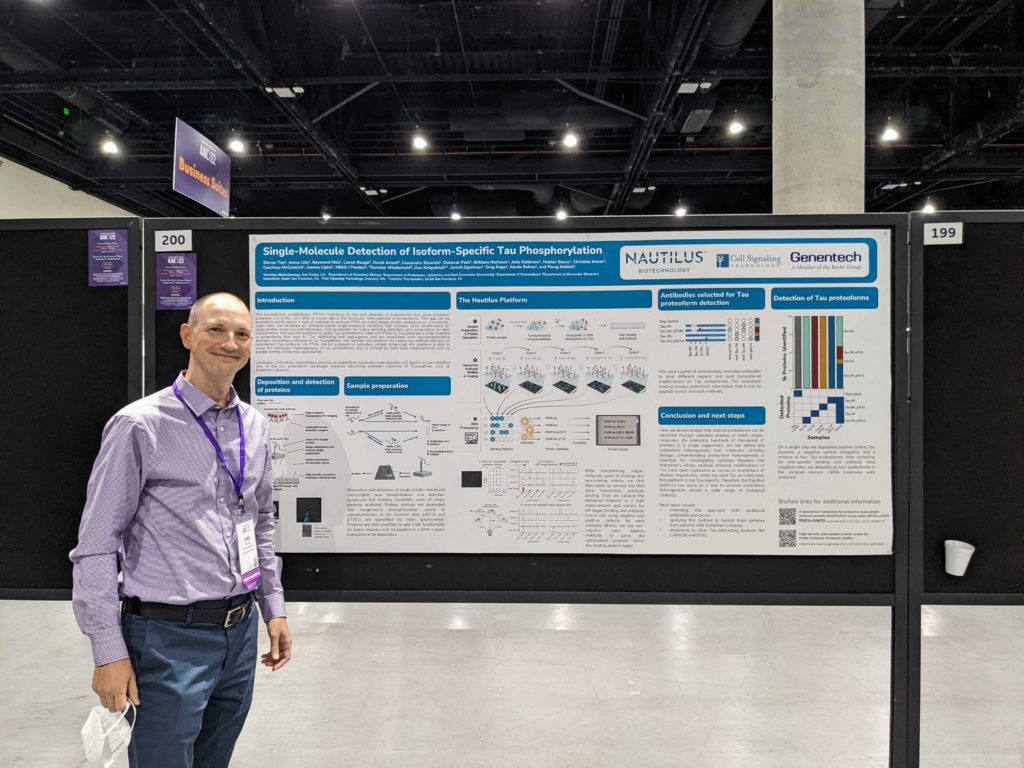
Proteomics could unlock how tau protein and Alzheimer’s are linked

Greg Kapp
November 8, 2022

Despite concerted efforts to understand Alzheimer’s disease and the many hypothesized causes of Alzheimer’s disease over the past decades, the disease remains a challenge for researchers and a devastating diagnosis for families. However, the growing field of proteomics could soon offer new answers.
On the surface, we watch as the animate light in someone’s eyes slowly dims and they try to grasp at memories that are no longer there. In their brain, a slow buildup of proteins forms beta amyloid plaques and tau tangles, both of which seem linked with Alzheimer’s disease progression and decreased neural function. Understanding how tau proteins and Alzheimer’s are linked will help us better understand and treat not only Alzheimer’s, but also many other diseases. To get there, we need a better understanding of specific proteins like tau and the whole proteome, the collection of all the proteins inside cells and tissues. The growing field of proteomics, and new technologies like the cutting-edge Nautilus Proteome Analysis Platform, could be the solution.
Tau protein an Alzheimer’s disease
Alzheimer’s disease is usually linked with dementia or cognitive decline, which can be hard to differentiate from the natural consequences of aging. One strategy for early diagnosis of Alzheimer’s disease (and then treatment) is to identify specific protein biomarkers, like beta amyloid and tau proteins, that may be involved or change in the early stages of the disease. Some current theories hold that these proteins could be misfolding and aggregating, collecting in the brain, disrupting normal cellular function, and leading to cognitive declines.
There’s still debate about the role these different proteins play in Alzheimer’s. However, it’s clear that more information on biomarker proteins that either distinguish Alzheimer’s disease or differentiate the various stages of the disease would improve patient care, diagnosis, and clinical feedback on new therapies.
Identifying the early stages of Alzheimer’s disease is particularly important for improving patient lives because, if researchers can develop therapeutics that address these early stages, we may slow or stop progression to wider brain dysfunction. Identifying specific variations of the tau protein, called proteoforms, may be the key to developing improved biomarkers for Alzheimer’s early stages.
To achieve this, we need to be able to more thoroughly characterize the tau protein. For that, it’s essential to have new tools that enable high-throughput protein quantification and identification while also providing more detailed analysis of specific proteins and proteoforms. This deeper level of investigation, into both the whole proteome and individual proteins and proteoforms, will improve our understanding of Alzheimer’s biomarkers and biology. That requires groundbreaking new approaches in proteomics technology, much like what we’ve seen in the field of genomics. We hope the Nautilus platform will provide this quantum leap in proteomic analysis.
Using the Nautilus Proteome Analysis Platform to probe the tau protein
We’ve been studying the tau protein and its proteoforms using the Nautilus Proteome Analysis Platform in collaboration with Genentech. We shared some of our preliminary findings during a recent poster presentation at the Alzheimer’s Association International Conference (AAIC), the world’s largest dementia research forum. Our data shows how we can use commercial antibodies (existing tools) coupled with the powerful single-molecule analysis capabilities of the Nautilus platform to learn more about the proteoforms associated with Alzheimer’s disease. In this case, we used antibodies targeting tau protein and tau phospho-proteins to explore the different tau proteoforms that might exist in a sample.
The tau protein can be highly modified in our bodies — it is one of the human proteins with the most identified post-translational modifications. This makes tau protein analysis incredibly challenging because there are hundreds to thousands of possible tau proteoforms. The tau proteoform distribution (the complete set of existing proteoforms) changes over time in healthy patients, over the course of disease, between various parts of the body, and possibly over the course of treatment. This incredible complexity makes understanding tau proteoforms and their biological relevance to diseases like Alzheimer’s difficult. Nonetheless, it highlights how much there is to learn about tau and underlines the need for technologies like the Nautilus platform that enable us to look deeper into tau proteoforms and how they can cause Alzheimer’s and other diseases.
Alzheimer’s disease proteomics
Our goal is to demonstrate that a new approach to protein and proteoform analysis can improve human health. The collaboration with Genentech is focused on tau and Alzheimer’s disease, but there are other proteins, like beta amyloid, hypothesized to be involved in Alzheimer’s disease as well. The Nautilus platform is built to enable deep protein analysis of tau and any other protein that could be a key Alzheimer’s biomarker or therapeutic target. Nautilus’ overall goal is to enable scientists and researchers to dig deeper into protein analysis of specific proteins, proteoforms, and whole proteomes. Having access to this kind of deep proteomic analysis will revolutionize our understanding of the complexities of human proteins and complement other technologies to shape the next 10 years of advancements in how we understand, diagnose, and treat disease.
While our current collaboration with Genentech is focused on Tau and Alzheimer’s disease, there are many other proteins hypothesized to be involved in the onset and progression of Alzheimer’s disease. The Nautilus platform is built to enable deep analysis of Tau and of any protein that could be a key biomarker or therapeutic target. Our overall goal is to enable deeper protein analysis of specific proteins and proteoforms, and of whole proteomes. Having access to this kind of deep analysis will revolutionize how we understand the complexities of human proteins and complement other technologies to shape the next 10 years of advancements in how we visualize, measure, and treat disease.
MORE ARTICLES
